BIOL1001 Midterm
Which is a good way to test the “excess acid” hypothesis?
A. Examine ulcer patients of a range of ages and measure their stomach acid levels.
B. Have all volunteers drink alcohol and measure their stomach acid levels.
C. Lower stomach acid levels of some volunteers (using drugs/antacids), and measure numbers of ulcers in all volunteers.
D. Examine patients of a range of ages and measure the number of ulcers in each person. E. Put all volunteers through a stress test and then measure their stomach acid levels.
C is the best choice here because acid levels would be controlled in some ulcer patients, allowing us to determine if there is a direct connection between acid levels and ulcers.
What step in the scientific method would this test (the one about testing he excess acid hypothesis) represent?
A. Making observations.
B. Developing a hypothesis.
C. Determining predictions.
D. Testing a hypothesis.
D
1/295
Name | Mastery | Learn | Test | Matching | Spaced |
|---|
No study sessions yet.
296 Terms
Which is a good way to test the “excess acid” hypothesis?
A. Examine ulcer patients of a range of ages and measure their stomach acid levels.
B. Have all volunteers drink alcohol and measure their stomach acid levels.
C. Lower stomach acid levels of some volunteers (using drugs/antacids), and measure numbers of ulcers in all volunteers.
D. Examine patients of a range of ages and measure the number of ulcers in each person. E. Put all volunteers through a stress test and then measure their stomach acid levels.
C is the best choice here because acid levels would be controlled in some ulcer patients, allowing us to determine if there is a direct connection between acid levels and ulcers.
What step in the scientific method would this test (the one about testing he excess acid hypothesis) represent?
A. Making observations.
B. Developing a hypothesis.
C. Determining predictions.
D. Testing a hypothesis.
D

Which graph most closely matches the results you predict if the “excess acid” hypothesis is supported?
B
Warren and his colleagues treated ulcer patients with antibiotics to see if the disease stopped. Given this information, what is missing from their study?
A. An experimental treatment.
B. A control group.
C. An independent variable.
D. A dependent variable.
E. A hypothesis.
B
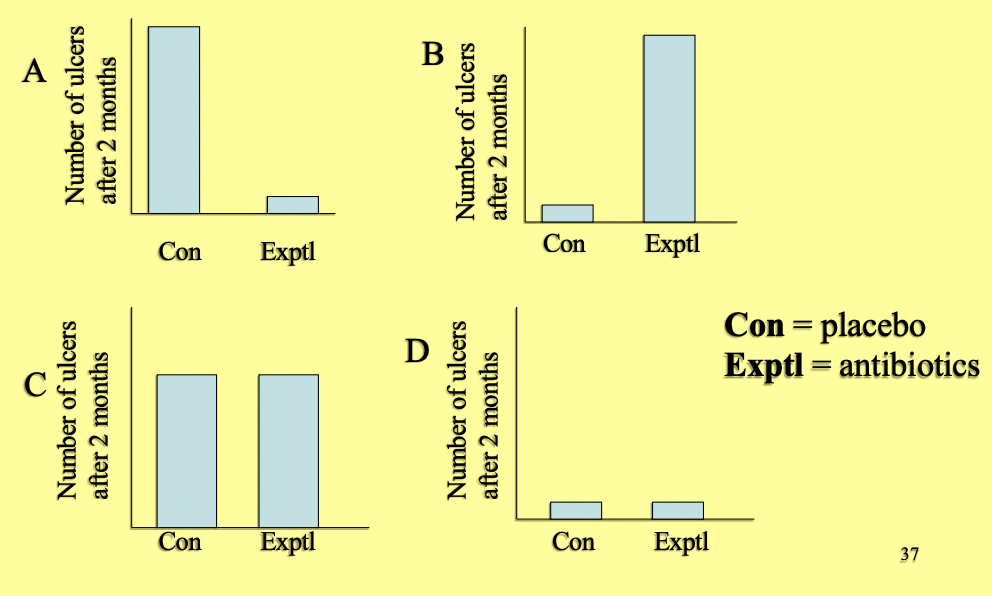
What results would you expect if the old “excess acid” hypothesis was true and the reason for the ulcers?
C
Why not D? These are individuals with ulcers (chosen for the study) Note, axis scales are arbitrary
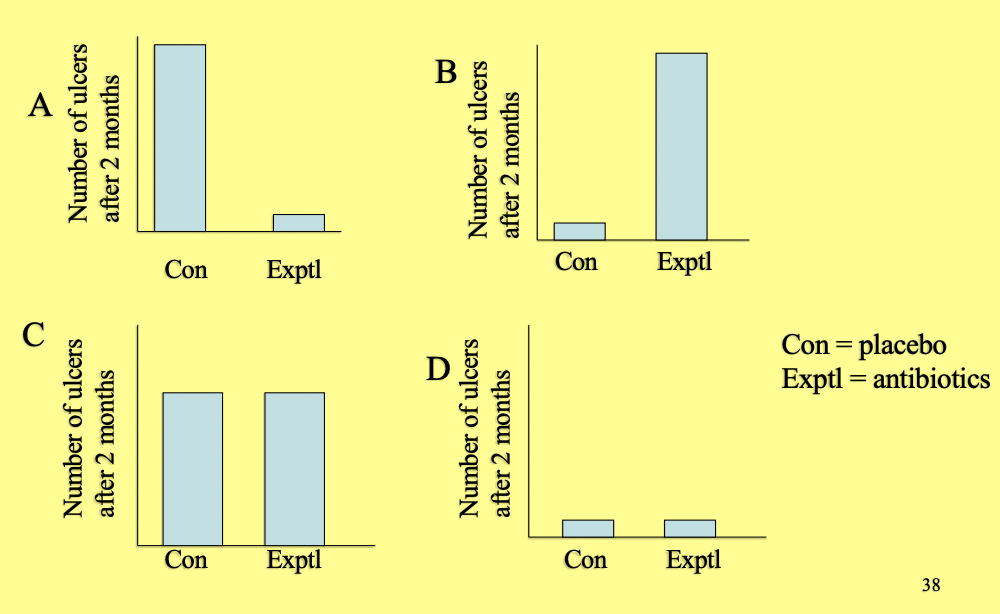
What results would you expect if the “bacteria cause ulcers” hypothesis was supported?
A
Relative to the “excess acid” hypothesis, the “bacteria cause ulcers” hypothesis represents
A. an experimental group.
B. a control group.
C. an alternative hypothesis.
D. a null hypothesis.
C
Which species is most similar to Goldie’s bird-ofparadise, Paradisaea decora?
a) Valenciennea decora
b) Paradisea lusitanica
c) Ornithoptera paradisea
d) Paradisaea rudolphi
d
In the scientific name below, Davida involucra Baillon the third word is the
a) authority who named the species
b) subspecific name
c) specific name
d) genus
a
Which of the following ranks is more inclusive than infraclass, but less inclusive than subphylum?
a) subclass b) suborder c) superorder d) family
a
What is the order of ranks in classification?
Subphylum > Infraphylum > Superclass > Class > Subclass > Infraclass
Monarch butterflies belong to the genus Danaus, the order Lepidoptera, the class Insecta and the family Nymphalidae. All members of the family Nymphalidae have brush-like hairs on their lower legs. The same brush-like hairs will be found on the lower legs of any other member of
a) the order Lepidoptera
b) the genus Danaus
c) the class Insecta
d) All of the above
b) Genus is nested within family; traits that define a family will be present in all genera within that family (and species within those genera)
Which of the following statements is attributable to Georges Cuvier?
a) If an organ is used it strengthens and grows; if it isn’t used it weakens and shrinks
b) Slow, subtle processes, acting over long periods of time, can have a dramatic effect
c) Fossils in older sedimentary rock strata bear less resemblance to modern organisms than those from recent strata
d) Geological processes operating today are the same as those that have operated in the past
c
At which of the following locations did Darwin observe evidence that Hutton and Lyell’s claim about the extreme age of the earth was correct?
a) Pampas Grasslands
b) Cape Horn
c) Australia
d) Andes mountains
d
The abundance of marsupials in Australia
a) is a result of their superior adaptation (compared with placental mammals) to the Australian environment
b) suggests that the shared ancestor of Australian mammals was a marsupial
c) is due to the introduction of marsupials to that continent by Europeans
b
Convergent evolution results in
a) closely related species that are physically similar
b) distantly related species that are physically similar
c) closely related species that are physically dissimilar
d) distantly related species that are physically dissimilar
b
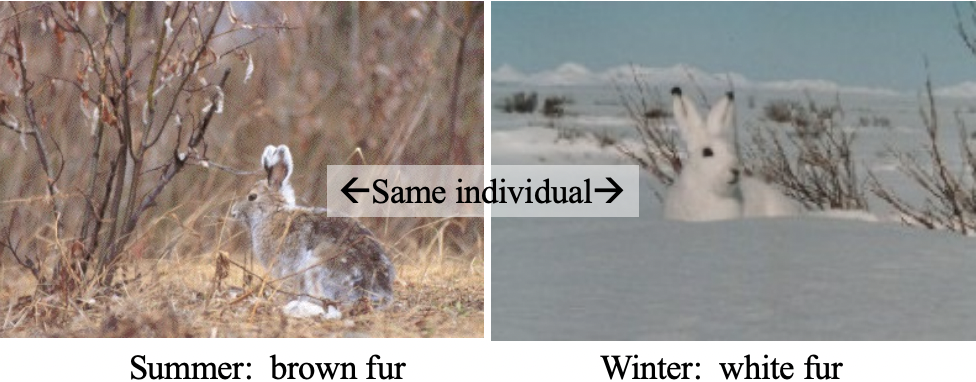
Is this an evolutionary change?
a) Yes
b) No
b
Lacecap hydrangeas produce flowers that are either blue or pink. The same individual can produce flowers of either colour, depending on the pH of the soil at the spot in which it is growing. A population of lacecaps contains a mixture of blue- and pinkflowered individuals due to local variation in soil pH. The ratio of blue- to pink-flowered plants is 2:1. Pollinators in the area frequently visit the blue-flowered plants, and rarely visit the pinkflowered plants; as a result, blue-flowered plants produce more viable seeds. Based on this information, what do you predict will happen to the frequency of blue flowers in this population over time? The frequency of blueflowered plants will
a) increase
b) decrease
c) not change
c)
Blue flowers are not genetically different from pink. Selection can occur – i.e., blue-flowered plants may leave more offspring – but it will not result in evolution if there is no allele for blue flowers.
A population of moths lives in a forest of birch trees. The population consists entirely of individuals that are white; there are no dark-coloured moths. These white moths are well camouflaged when resting on tree trunks, which they do during the daytime to hide from birds, their natural predators. A factory opens nearby, and the tree trunks become polluted with smoke particles, turning them black. The white moths are now very conspicuous to birds. What will happen to this population over time, and why?
a) It will most likely evolve to become a population of darkcoloured moths
b) It will most likely go extinct
b) Most likely, the population will go extinct. Natural selection cannot create black moths; new variations are created by random processes, such as mutation. Since mutations are rare, it is unlikely that a mutant will appear by chance before the population goes extinct (though not impossible). Populations that maintain some genetic variation have less chance of going extinct if there is a sudden change in the environment.
A population consists of 25 people with the genotype AA 40 people with the genotype Aa 35 people with the genotype aa What are the frequencies genotypes AA, Aa, and aa, respectively?
a) 25, 40 and 35
b) 12.5, 20 and 17.5
c) 0.25, 0.40 and 0.35
d) 0.125, 0.20 and 0.175
e) 0.50, 0.80 and 0.70
c
Total # genotypes = 25+40+35 = 100 Freq AA = 25/100 = 0.25 Freq. Aa = 40/100 = 0.40 Freq. aa = 35/100 = 0.35
What is the frequency of the allele A? Of the allele a? 25 people with the genotype AA 40 people with the genotype Aa 35 people with the genotype aa
a) 0.25 and 0.35, respectively
b) 0.65 and 0.75, respectively
c) 0.65 and 0.35, respectively
d) 0.55 and 0.45, respectively
e) 0.45 and 0.55, respectively
e
Total # people = 100 ∴ total # alleles = 200 Freq A = p = (25*2 + 40)/200 = 0.45 Freq a = q = (40 + 35*2)/200 = 0.55
What are the frequencies of the dominant and recessive traits (i.e. phenotypes), respectively? 25 people with the genotype AA 40 people with the genotype Aa 35 people with the genotype aa
a) 0.65 and 0.35
b) 0.25 and 0.75
c) 0.25 and 0.35
d) 0.40 and 0.60
e) 0.35 and 0.65
a
Total # phenotypes (i.e. people) = 100 Freq dominant phenotype = (25 + 40) / 100 = 0.65 Freq recessive phenotype = 35 / 100 = 0.35
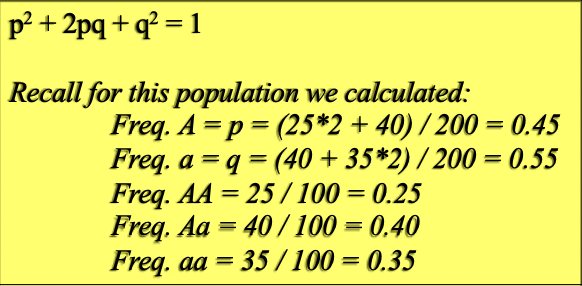
Is the population from Questions 1-3 in Hardy-Weinberg equilibrium? 25 people with the genotype AA 40 people with the genotype Aa 35 people with the genotype aa
a) Yes
b) No
b
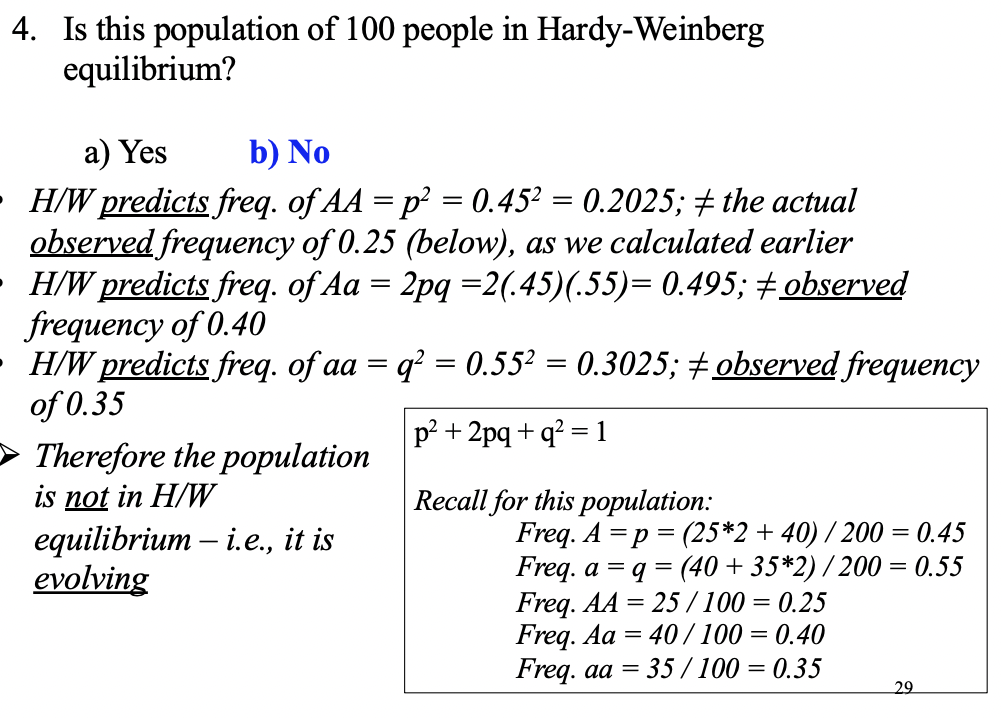
Is this population of 100 people in Hardy-Weinberg equilibrium? 16 people with the genotype AA 48 people with the genotype Aa 36 people with the genotype aa
a) Yes
b) No
a
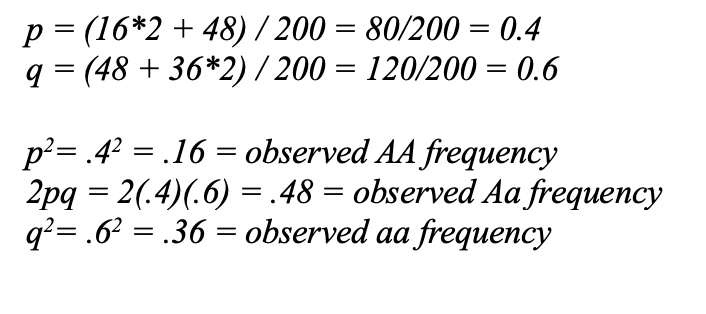
Cystic fibrosis is a disorder caused by a recessive allele. In the United states, one child out of every 2,500 is born with this disorder. What proportion of the population consists of healthy people who are carriers of the allele? Assume the population is in Hardy-Weinberg equilibrium. Round your answer to 2 significant digits.
a) 0.00080
b) 0.020
c) 0.039
d) 0.96
e) 0.98
c
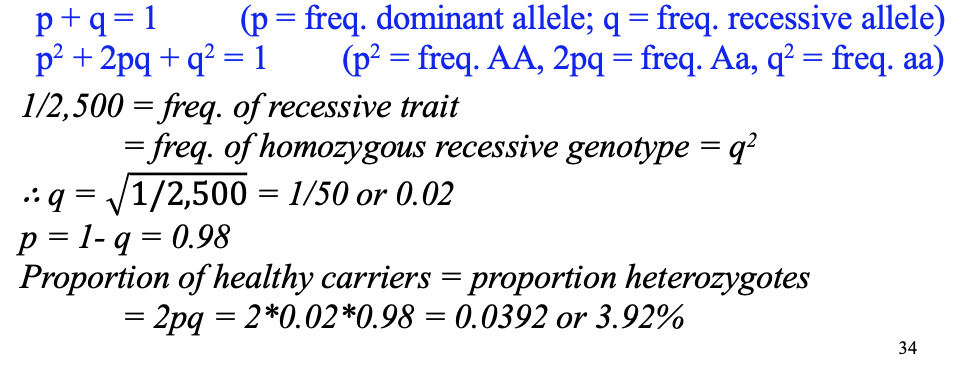
Recall: In the United states, one child out of every 2,500 is born with cystic fibrosis. What proportion of the U.S. population consists of people who do not have cystic fibrosis and are not carriers of the c.f. allele? Assume the population is in Hardy-Weinberg equilibrium and round your answer to 2 significant digits.
a) 0.00080
b) 0.020
c) 0.039
d) 0.96
e) 0.98
d

A widow’s peak is widely believed to be a dominant Mendelian trait, while a straight hairline is recessive. (This is controversial, but assume that it is correct). Fifty one percent of the people in a population have a widow’s peak. What is the frequency of the allele for a straight hairline? Assume that the population is in Hardy-Weinberg equilibrium.
a) 0.51
b) 0.70
c) 0.49
d) 0.30
e) 0.42
b

The moth population below is not in Hardy-Weinberg equilibrium, due to strong selection against the recessive phenotype (white moths). Other conditions for H-W equilibrium are met. If natural selection were to suddenly stop, how long would it take the population to return to HardyWeinberg equilibrium? (Assume there is no overlap between generations; after eggs are laid, all moths die before the next generation hatches). 250 individuals with the genotype BB 500 individuals with the genotype Bb 0 individuals with the genotype bb
a) One generation
b) Two generations
c) Three generations
d) More than three generations
e) More information is needed to answer
a
If all of the assumptions of Hardy-Weinberg are met, gametes will combine at random regardless of what genotype they originate from. The genotype frequencies in the next generation will be those predicted by Hardy-Weinberg, based only on current allele frequencies. This will be true no matter how far from equilibrium the genotype frequencies have strayed in previous generations.
If natural selection stops, what will be the genotype frequencies in the next generation of moths? 250 individuals with the genotype BB 500 individuals with the genotype Bb 0 individuals with the genotype bb The frequency of BB, Bb and bb will be
a) 0.33, 0.67 and 0
b) 0.44, 0.44 and 0.11
c) 0.25, 0.50 and 0.25
d) 0.67, 0.33 and 0
e) More information is needed to answer
b

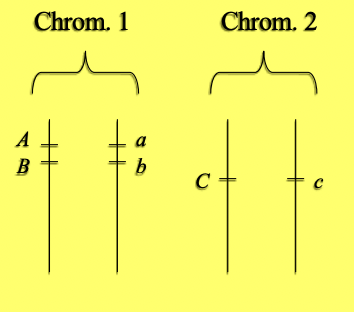
Gene a (alleles A and a) and gene b (alleles B and b) are located close together on the same chromosome, with dominant or recessive alleles tending to occur together; gene g (alleles C and c) is located on a different (non-homologous) chromosome. Natural selection is acting to increase the frequency of allele A in a population. What can be said of this population? The frequency of genotypes for gene a can be calculated using the Hardy-Weinberg equation
a) True
b) False
b
Natural selection is acting directly on the frequencies of A and a, so the population will not be in Hardy-Weinberg equilibrium
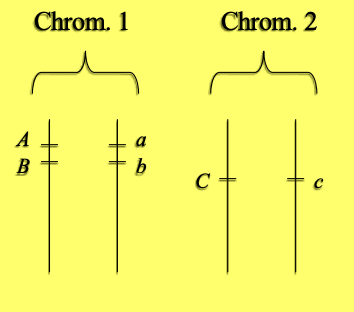
Gene a (alleles A and a) and gene b (alleles B and b) are located close together on the same chromosome, with dominant or recessive alleles tending to occur together; gene g (alleles C and c) is located on a different (non-homologous) chromosome. Natural selection is acting to increase the frequency of allele A in a population. What can be said of this population? The frequency of genotypes for gene b can be calculated using the Hardy-Weinberg equation
a) True
b) False
b
Alleles A and B are linked and will tend to be inherited together; if gene a is not in HardyWeinberg equilibrium, gene b will not be either. If the chromosome with allele A is passed on more frequently to the next generation than the one carrying a, then allele B (which is close to A on the same chromosome) will also be passed on more frequently than its recessive counterpart. Alleles A and B are linked and will tend to be inherited together; so if gene a is not in HardyWeinberg equilibrium, gene b will not be either.
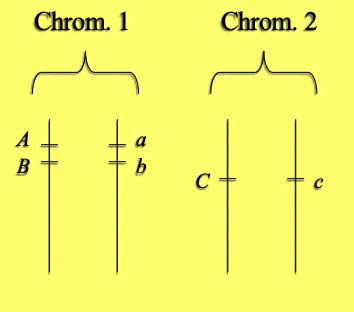
Gene a (alleles A and a) and gene b (alleles B and b) are located close together on the same chromosome, with dominant or recessive alleles tending to occur together; gene g (alleles C and c) is located on a different (non-homologous) chromosome. Natural selection is acting to increase the frequency of allele A in a population. What can be said of this population? The frequency of genotypes for gene g can be calculated using the Hardy-Weinberg equation
a) True
b) False
a
Alleles on chromosome 2 assort independently of those on chromosome 1. The fact that an individual has a chromosome with allele A in no way influences whether it has allele C or c.
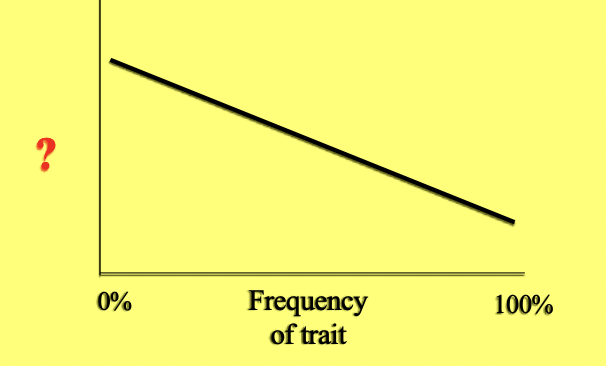
In negative frequency-dependent selection, the frequency of a morph is always negatively correlated with ______________________.
a) the rate at which it is attacked by a predator
b) its fitness
c) its survival rate
b) fitness. It may also be negatively correlated with survival rate, but fitness (ability to reproduce relative to other members of the population) is what ultimately determines the frequency of any trait in a population.
If a population is not in H-W equilibrium, the frequencies of the three genotypes (homozygous dominant, heterozygous and homozygous recessive) will not add up to 1
a) True
b) False
b
Frequencies always add up to 1.0 (or to 100% if expressed as percentages). When adding three numbers, there are many different combinations that can yield a total of 1.0. But only one combination will correspond with the genotype frequencies of a population in H-W equilibrium.
In leaf mantids, individuals of an intermediate shade of green (closely matching the vegetation they rest on) are less likely to be eaten by birds than those of a lighter or darker shade of green. What type of selection has produced the camouflage colouration of these insects?
a) Directional
b) Stabilizing
c) Disruptive
d) Positive frequency-dependent
e) Negative frequency-dependent
b
Retinitis pigmentosa is a recessive genetic disorder. The first symptom is night blindness, followed by loss of peripheral vision, eventually leading to total blindness. In Europe, one person in every 4,000 is born with the disorder. On the island of Tristan da Cunha in the South Atlantic (population = 264), the frequency of the disorder is much higher: one child in 60 is born with the condition. It is believed that one of the original 15 European colonists of the island (there is no indigenous population) was a carrier of the recessive allele. The high frequency of this disorder among the islanders is due to which of the following?
a) natural selection
b) the bottleneck effect
c) mutation
d) the founder effect
e) gene flow
d)
Why not e? Gene flow occurs between two established populations Why not b? The bottleneck effect occurs as a result of massive mortality Frequency of the allele in Europe = (1/4000)0.5 ~ 1/63 Frequency of the allele among the original colonists = 1/30
Which of the following isolation mechanisms will not prevent an egg of one species from being fertilized by the sperm of a different species?
a) Habitat isolation
b) Mechanical isolation
c) Gametic isolation
d) Reduced hybrid fertility
e) Behavioural isolation
d)
All of the other mechanisms are pre-zygotic (prevent a hybrid zygote from being formed) Reduced hybrid fertility acts after a hybrid has been formed, preventing that hybrid from passing its alleles into the gene pools of either of its parent species
Under the biological species concept, each species maintains a set of distinctive characteristics because of
a) genetic drift between populations
b) gene flow between populations
c) stabilizing selection within populations
d) the requirements of its ecological niche
b
A diploid plant with 5 pairs of chromosomes (10 chromosomes total) undergoes sympatric speciation by autopolyploidy. How many chromosomes will each somatic cell of its daughter species have?
a) 5
b) 10
c) 15
d) 20
e) 40
d)
In autopolyploidy, the daughter species has 2X as many chromosomes as the (one) parent species
How many homologous copies (i.e., alleles) of each gene (or genetic locus) will the daughter species from the previous question 1 have?
a) 1
b) 2
c) 4
d) 6
e) 8
c
Species A (2n = 6) and species B (2n = 4) form a new species, C, by allopolyploidy. Species C then undergoes autopolyploidy, forming species D. How many chromosomes will the somatic cells of species D contain?
a) 10
b) 20
c) 24
d) 40
b

Hybrids (H. anomalus) of H. annuus and H. petiolaris are fertile. Why don’t these three sunflower species “blend” into one uniform species?
a) reduced hybrid fertility
b) gametic isolation
c) habitat isolation
d) reduced hybrid viability
c
The hybrid has a unique combination of traits that allow it to live in a different habitat (sand dunes) from either of its parent species (riverbanks and prairies) therefore does not interbreed with parental species very often
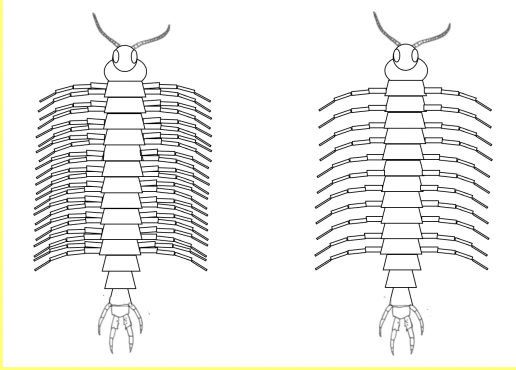
The fossil organisms below occur in adjacent strata within a sedimentary rock profile. The fossil on the right is estimated to be 10,000 years older than the fossil on the left. If the older fossil is the direct ancestor of the recent fossil, which of the mechanisms below is most likely responsible for this evolutionary change?
a) Duplication of a non-homeotic gene
b) Heterochrony
c) Mutation of a Hox gene
d) Exaptation
e) Change in the regulation of a non-homeotic gene
c
What is a theory?
a hypothesis that has been confirmed or established by observation or experiment, and is propounded or accepted as accounting for the known facts; a statement of what are held to be the general laws, principles, or causes of something known or observed
Who were some progenitors of evolutionary thought before Darwin?
Anaximander, Empedocles, Plato Aristotle Carolus Linnaeus
What did Anaximander contribute to evolutionary thought?
life originated in the oceans
What did Empedocles contribute to evolutionary thought?
life forms originally assembled by random processes and those that were unsuccessful died out
What did Plato contribute to evolutionary thought?

What did Aristotle contribute to evolutionary thought?
scale/ladder of nature - ordering of species from least to most ‘perfect,’ implication is that there is no evolution; Great Chain of Being
What is natural theology?
the study of nature in order to better understand God; incorporated ideas of Aristotle
What are adaptations?
traits that help organisms survive and reproduce in a particular environment
How was biological evolution a threat in 1700s Europe?
the idea of biological evolution was seen as a subversive threat to the ruling class – if species are not ‘meant’ to play a specific role in nature, perhaps people are not ‘meant’ to be dominant or subservient
What did Carolus Linneaus contribute to evolutionary thought?
inventor of taxonomy, binomial naming system for all species, 7-level hierarchal classification system
What is taxonomy?
the science of naming and classifying living things
Describe how the binomial classification system works
first word is the Genus, second word is the specific name/epithet
What are the seven hierarchies in classification? What is a recent addition? How can additional levels be created?
Kingdom (group of similar phyla), Phylum (group of similar classes), Class (group of similar orders), Order (group of similar families), Family (group of similar genera), Genus (group of similar species), Species (group of similar individuals); Domain - adds an eighth level to the hierarchy; additional levels can be created using super-, sub-, and infra- prefixes
What is Linnean classification based on? How is it different from how Aristotle classified?
morphology (appearance/shape); Aristotle based on function
What is authority in reference to taxonomy?
name of taxonomist who assigned the scientific name, sometimes included in the full name of species
What is a subspecies?
geographically distinct ‘races’ or ‘varieties’ that are represented with a third subspecific name/epithet
How are unknown'/unidentified species denoted?
with ‘sp.’
How are multiple species in a genus denoted?
with ‘spp.’
How are common names used in taxonomy?
not capitalized unless they occur at the beginning of a sentence or if they contain proper names (e.g. Goldie’s bird-of-paradise, American herring gull, etc.)
Describe the Ulcers Case Study.
§ Sores develop in the lining of the upper digestive tract leading to bleeding, perforation, or other emergencies; 20th century: excess acid hypothesis; § In 1979 Dr. J. Robin Warren (pathologist) examined stomach biopsies of patients with various stomach ailments using a high-power microscope and noticed unusual characteristics in stomach biopsy samples of ulcer patients, Thought he saw bacteria, but no one believed him because it was widely assumed that the stomach was too acidic for bacteria to survive, hypothesized that the bacteria CAUSE ulcers; When treated with antibiotics, 80% of patients were permanently cured of their ulcers
Describe the four models of the diversity of life and how they’ve changed through time.
Typological thinking: based on the idea that species are unchanging types and that variations within species are unimportant or even misleading
Great Chain of Being: species are fixed types organized into a sequence based on increased size and complexity
Lamarckian Evolution: progressive in the sense of always producing larger and more complex/better species, an individual’s phenotype changes as that individual develops in response to the challenges posed by the environment and these changes are passed on to offspring (giraffes develop long necks to reach leaves)
Population Thinking: claim that variation among individuals in a population was the key to understanding the nature of species
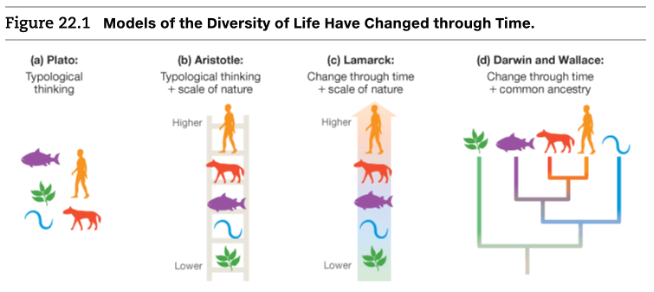
what are fossils?
mineralized remains or impressions of organisms from the past, preserved in rocks
What did Georges Cuvier contribute?
first to propose the concept of extinction (some species that lived in the past are no longer present today); made three observations about fossils: they occur in sedimentary rock layers (form under water), each stratum has its own distinctive set of fossils, and fossils in older strata tend to be more different from modern-day organisms than those from recent strata; theory of Catastrophism (catastrophes periodically wipe out local organisms)
What did James Hutton contribute?
theory of gradualism: geological features are create by slow, subtle processes; these processes act over very long periods of time, producing dramatic results
What did Charles Lyell contribute?
theory of uniformitarianism: geological processes operating today are the same processes that operated in the past, no ‘one-off’ catastrophes
What did James ussher believe?
earth was created around 6pm on Oct 22, 4004 BC
What did Jean-Baptists de Lamarck contribute?
supported biological evolution, interpreted fossil record as evidence that species had changed over time; Lamarck’s principles of nature: use an organ and it grows and strengthens, don’t use an organ and it shrinks and disappears, inheritance of acquired characteristics
What did August Weismann contribute?
tested Lamark’s theory; cut off tails of mice for 22 generations and the 23rd generation still developed fully formed tails
What did Darwin observe in the South American Mainland?
flora and fauna of S. America differ from those of Europe but both have a temperate climate; similar species tend to be geographically clustered, species from one continent tend to be distinctive; fossil animals of the Pampas Grasslands - living species resemble other species that are now extinct, perhaps related; Andes fossilized trees at 7000 ft - once near ocean
What did Darwin observe in Australia?
Australian mammals are mostly marsupials and elsewhere, mammals are mostly placental mammals; hypothesis that Australian environment is better suited for marsupials than placentals which is not the case; His alternate hypothesis: in Australia, the marsupial body plan was the ‘starting material’ that was modified on the outside to produce a variety of different forms ecologically similar to European placental mammals; Australian marsupials are ecologically equivalent to placental mammals elsewhere
What are the three general types of mammals?
Monotremes (lay eggs), Marsupials (live young complete development in mother’s pouch), Placental (live young, developing fetus attached to mother’s uterus and born in more fully developed condition)
What is convergent evolution?
when species that are not closely related acquire similar adaptations as a result of living in similar environments
Describe the theory of plate tectonics
earth’s crust (lithosphere) consists of interlocking plates ‘floating’ on a molten interior (mantle); subduction zones where plates are colliding and one is forced below the other; sea-floor spreading, continental plates moving
How do Pangaea and the Bering Land Bridge relate to the distribution of species?
Ø Egg-laying mammals evolved ~220 million years ago during the time of the supercontinent Pangea these early mammals spread throughout the interconnected land masses of the world
Ø Marsupials and placentals both appeared ~120 mya in Eurasia and spread over the Bering Land Bridge (connected eastern Russia with Alaska, has formed and disappeared repeatedly in the Earth’s recent history) into the Americas
Ø From the Americas marsupials spread into Antarctica and Australia while these continents were still close together
What did Darwin observe in the Galapagos Islands?
marine and land iguanas - marine have webbed feet, flattened tails, can hold breath up to 1 hour…land iguanas differ in colouration around the island; mockingbirds differ as well; finches with different beak shapes feed on different foods; tortoises shell shape differs from island to island, adapted to the local food source
What did Darwin hypothesize causes the change in species over time and over area?
artificial selection and natural selection
What is artificial selection?
humans select individuals to breed that have desirable qualities which creates new breeds
What is natural selection?
only those individuals best adapted survive to breed which leads to species changing slowly
How did Ernst Mayer summaize Darwin’s theory in five observations?
Observations:
· All species have the capacity to increase in number geometrically (by a constant factor) if all their offspring survive to reproduce
¨ E.g. 1->2->4->8->16->32 (factor of 2, under ideal conditions, bacteria divides every 20 mins = after 36 hours 2^108 = 3.245x10^32 cells)
· Populations tend to remain stable in size
· Environmental resources are limited (food, nesting sites, etc.)
· No two individuals in a population are exactly alike
Some of this variation is heritable (individuals tend to resemble their parents
§ Inferences:
· Individuals struggle for existence, only a fraction survive to reproduce
· Survival depends partly on genetic makeup (individuals whose inherited characteristics best fit them to their environment are likely to leave more offspring (natural selection)
· Unequal ability to survive and reproduce leads to gradual change in the makeup of populations (individuals with favourable characteristics make up a progressively greater percentage of the population over time = evolution)
How does natural selection affect allele frequency?
increases the frequency of certain alleles, the ones that contribute to reproductive success in a particular environment
How does genetic drift affect alleles?
causes allele frequencies to change randomly, sometimes causes alleles that decrease fitness to increase in frequency
What is gene flow? How does it affect allele frequency?
occurs when individuals leave one population, join another, and breed; allele frequencies may change because arriving individuals remove alleles from their old population
How does mutation affect allele frequency?
modifies allele frequencies by continually introducing new alleles, might be beneficial or deleterious or have no effect
What are the kinds of natural selection?
directional selection, stabilizing selection, disruptive selection, balancing selection
What is disruptive selection?
changes the average value of a trait; Tends to reduce genetic variation; When directional selection acts on traits that have a normal distribution, individuals at one end of the distribution have poor reproductive success
What is stabilizing selection?
eliminates individuals in both tails of the distribution; reduces variation in a trait; Reduces both extremes in a population; Consequences: genetic variation is reduced but there is not change in the average value of a trait over time; · E.g. babies of average size survive best while very small and very large babies have a high mortality rate
What is disruptive selection?
increases variation in a trait; Eliminates phenotypes near the average value and favours extreme phenotypes; Overall genetic variation in population increases; · E.g. birds with large beaks can break large seeds efficiently, birds with small beaks can break small seeds efficiently, birds with medium beaks have trouble with both
What is balancing selection?
natural selection that maintains genetic variation in a population; leads to balanced polymorphism; maintains variation in a trait; Occurs when no single allele has a distinct advantage, there is a balance amond several alleles in terms of fitness and frequency; occurs when heterozygote advantage; certain alleles are favoured when hey are rare but not when they are common (frequency dependent selection); e.g. guppy colouration
What is genetic drift?
any change in allele frequency in a population due to chance
What is a founder event?
§ when a group of individuals immigrates to a new geographic area and establishes a new population
· if the group is small enough the allele frequencies are almost guaranteed to be different from the source population (Founder Effect)
What is a population bottleneck?
§ when a large population experiences a sudden reduction in size
· Genetic Bottleneck is likely to follow, where there is a sudden reduction in the number of alleles in a population
What are examples of nonrandom mating?
inbreeding, assortative mating, sexual selection, ecological/environmental selection
What is fitness?
ability to reproduce relative to other individuals in the population
What is the smallest unit that can evolve?
population
What are some subtleties of natural selection?
the smallest unit that can evolve is a population natural selection acts only on variation that is already present, natural selection can only cause evolution if variation is heritable, natural selection is not progressive (does not lead to greater complexity
What is some evidence for evolution/examples of natural selection in action? What kind of evolution are these examples?
industrial melanism, drug resistance, pesticide resistance, colouration of guppies; microevolution - evolution within a species
What is some evidence of macroevolution?
BIOGEOGRAPHICAL EVIDENCE (evidence from distribution of species) - e.g. silversword Hawaiin plant, ring species; HOMOLOGY (similarity of structure in organs with different functions) - e.g. pendactyl limb of vertebrates, vestigial structures, all mammals 28 skull bones, molecular homologies (genetic code same for every species); FOSSIL RECORD (order of appearance of fossils is consistent with evolutionary relationship) - gradient change in animals and plants over time - fish > amphibians > reptiles > mammals, transitional organisms like archaeopteryx